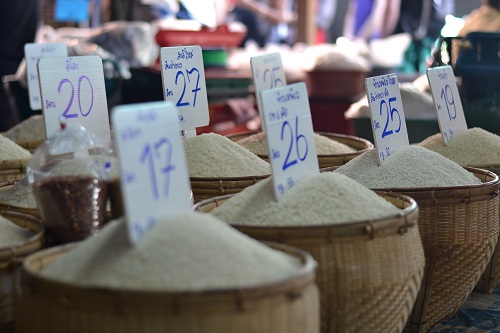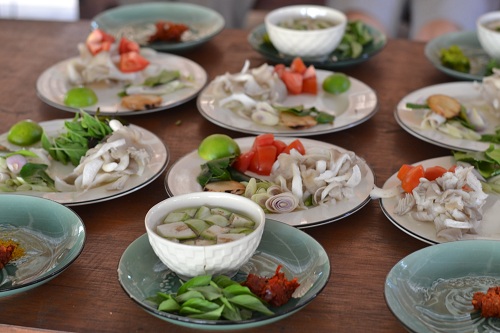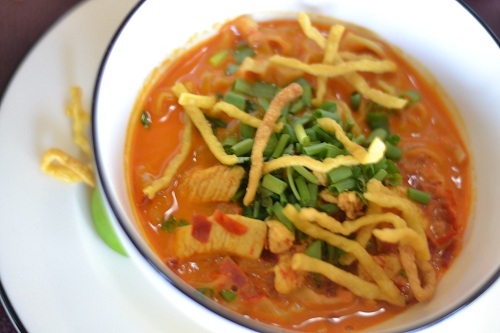Our family has a symbiotic relationship when it comes to food. I love to cook everyone loves to eat. So when I asked Sandeep to take care of the kids for a day while I learnt to cook Thai food, he happily obliged.
Choosing a cooking school in Chiang Mai is an event in itself. It seems as though everyone knows someone who runs one. Even Google yields 1,040,000 results for “cooking school Chiang Mai”. The food everywhere has been great, so I figured quality would be a given at any school. The variables came down to menu, instructor and location.
Almost every school had a five course menu of salad, soup, stir fry, curry, and dessert. I ruled out any schools that required the class to agree on parts of the menu as I had predetermined exactly which Thai dishes I wanted to perfect. Tripadvisor came in handy for reviews on instructors. In the end, I chose Asia Scenic Thai Cooking School because it offered a full day course on a farm. I also liked that the owner, Gayray, has a mission that “We would like to show every one in the world that Thai woman can run the business without a rich boyfriend.”
She runs a great business.
Our instructor, Maam, took us to a local market to explain the ingredients of the day. This was the most helpful part of the course as I have always been intimidated by Thai herbs. Galangal, lemon grass, kaffir lime, holy versus sweet versus hairy versus hot basil – all these were my barrier to cooking Thai food. We also learnt that rice prices in Thailand depend on species, origination and vintage. Sort of like wine. Some species, like jasmine, are preferred. Older rice commands a premium. Certain provinces are known for better crops in certain years.

Ingredients in hand, we drove to the farm in Mae Jo, about 20 minutes outside Chiang Mai. The farm would have been a great outing on its own, complete with hammocks, rocking chairs and an open view of the mountains.

Up close and personal, I sniffed and prodded each of the various roots and plants.
Maam is a drill sergeant who shouts her commands in an efficient manner. “NOW CHOP!” “STIR!” “FIRE OFF!” “KNIVES DOWN!” By the end of the class we were answering back with “Yes, Ma’am!” She blames her mannerism on being raised by an army father, but she has a great sense of humor and patience. This is her explaining the intricacies of a coconut.

Here are a few things I learnt from Maam.
Cooking Thai food, even the curries, is a quick matter. What takes time is the prep work, including all the chopping. Here are our mise en place for the curries and soups.

The reason prep work takes a while is that the ingredients are all fresh. Most Thai cooks make a daily visit to the market for produce and those that have a garden will use what’s grown at home. Even curry pastes are made fresh for the meal at hand rather than in bulk or bought. I learnt from our Tesco grocery run that processed products are much more expensive than fresh ones in Thailand, and are generally reserved for more Western foods such as cookies and drinks. While the West is obsessed with all things organic, Tesco is charging a premium for equivalent packaged goods. I’m assuming that the relative price of labor and farmland to industry must be low, thus making a fresh squeezed orange juice at the street corner a third of the price of a bottle from Tesco.
The school farm was so well stocked, it even had an oyster mushroom barn.

Most Thai dishes are a balance between sour, sweet, salty and spicy and the exact balance is up to the cook. That is why no two Pad Thais in Thailand taste the same. My most exciting revelation is that it is possible to make three distinct curries from red curry paste.
Below is today’s recipe for red curry paste. Just beware, as Maam says, that cooking is partly imagination, so this is somewhat approximate.
“HERE WE GO!”
1 shallot quartered
4 pods garlic smashed
thin cross slice of galangal root
1/2 inch peel of kafir lime
3 inch chopped lemon grass
1 inch chopped ginseng
4 dried red chilies, soacked and chopped
Pound all the ingredients except the chilies with a mortar and pestal. When the mixture is pasty, add the chilis and continue pounding until incorporated.
To make red curry, add the paste to about 2 tablespoons of boiling coconut milk and cook for one minute. Add chicken (or tofu) cook until done, then add about a cup of coconut milk until it boils. Add 2 tsp fish sauce and 1 tsp palm sugar (or maple syrup). Add some holy basil leaves. Heat and done.

To make penang curry, do the exact same thing as for red curry, except add in 1tsp of ground peanuts (or peanut butter) to the paste before cooking.
To make khao soi, a traditional Chiang Mai noodle soup, do the exact samething as for red curry, except add 1tsp of curry powder to the paste before cooking.

In addition to chicken, both red curry and penang curry traditionally include eggplants, but you can can add whatever veggies are handy. Both those curries are served with rice. Khao soi is served on egg noodles and topped with fried noodles and chives.
Between Maam’s instruction and my ability to experience the ingredients from their origination to my belly, I’ve overcome any fear I had about running a Thai kitchen. Those at home, you can hold me to a Thai dinner when we get back.

Diya this looks amazing!! I cant wait for our first Patel/Luke family dinner once you guys get back-I say the noodle soup with chicken and eggplant should definitely be on the menu!
Looking forward to showing off 🙂
So cool. Making me drool.
I know! We’ll do a dinner when we return and share our travel stories in person.
Bring some Kafir lime seeds/ seedlings with you to India…
Yeah, trying to find them. I got holy basil.
Hi ! You doing a great job documenting your adventures! I going try your recipe here!
Thanks! I hope it works 🙂 Use your imagination.
I kept a copy of this. Next weekend project.
Add more red chilies if you want it Goan style.
My mouth is watering!!! Looking forward to tasting your Thai meal any day! xoxo
Certainly – we can use the herbs from your kitchen garden.
D!! Have been absolutely loving your blog and following your adventure! Thoroughly enjoy reading about the culture and all the sights you’ve been visiting. The Thai class sounds amazing! Looking forward to a Thai meal in NYC 😉
So glad that you are following! Will definitely do a thai party when we get back.
Kao Soi is Burmese!!! The Northern Thais borrowed from us! 😀
Good point. My favorite dish here so far! Excited to know we’ll get it again In Burma 🙂
That sounds amazing. Just took a cooking course yesterday in Hoi An, one of thebest things of the trip so far, especially shopping in the local market. happy to trade you a Thai feast for Vietnamese when you get back!
You’re on, but I still need to work up to your spice level! We’re off to Penang tomorrow morning, where I plan to take a Malaysian cooking class. Enjoy the rest of your time in Vietnam.
Any recipes for Thai dessert? 🙂
We did learn to make a couple – the sticky rice and mango is so good, but the trick is to find good mangoes. We’ll go hunting in New York.
Hello
Diya,
I just realised we went to the same place! I discovers it today and have th same rice picture! 😉 it was amazing, best experience for me so far! So glad you loved it too!!! I had Gayray and she was fantastic too
That’s so great. The setting is so beautiful, and they make the recipes look so easy. Glad you had a good time there!